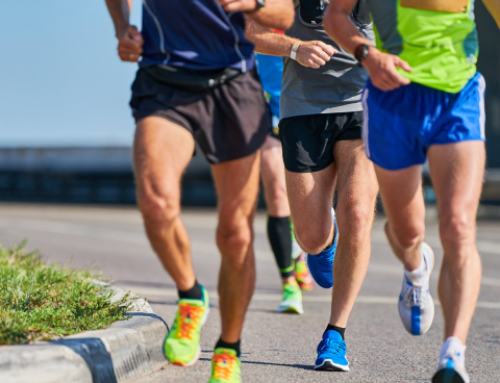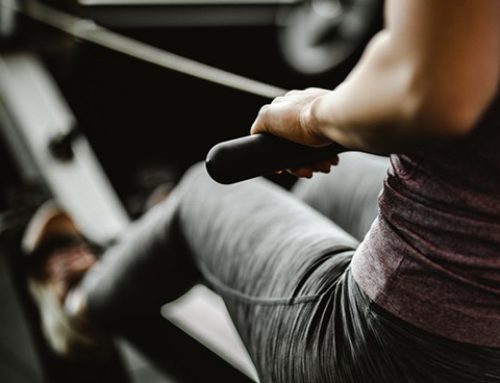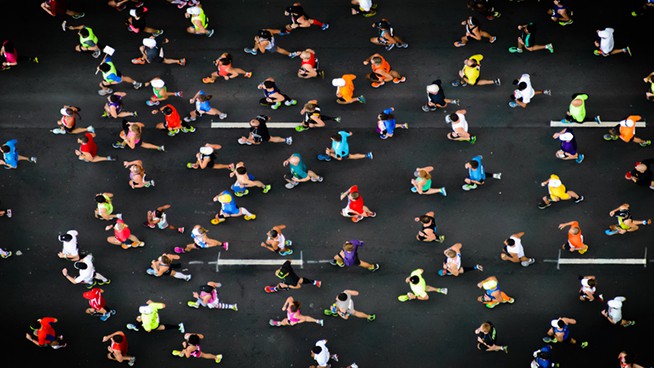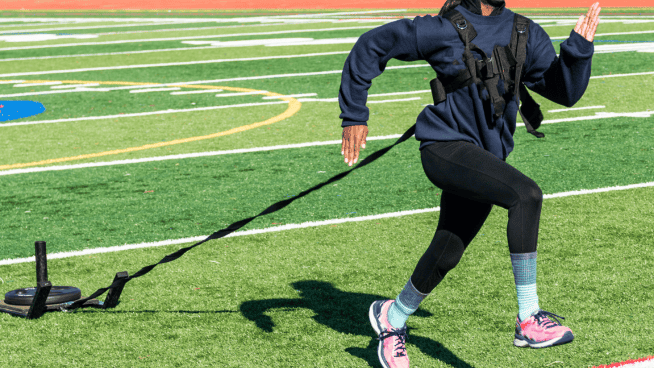5 Common Speed Training Mistakes That Will Cost You
![]()
What if you knew that athletes commonly make sprinting mistakes that are often reinforced by coaches and that cost the athletes speed performance? As a coach who has worked with both college and youth track & field athletes, I can tell you that bad habits are often instilled early and never corrected by training specialists who just don’t know any better.
With that, here are 5 common speed training mistakes, and how to address them for ultimate speed.
RELATED: Sprinting Tips from Olympic Gold Medalist Michael Johnson
1. Over-Cueing Knee Drive
Ever been to a speed training session? If so, there is a good chance you’ve heard the phrase “get your knees up!” quite a few times.
Knee drive is an aspect of sprinting that fluctuates. What is constant is the powerful drive of the glute, which locks the sacrum during ground strike. Vertical force production is also constant (although athletes naturally run with varying levels of “tallness”).
Athletes do need to drive their knees somewhat during sprinting—at least enough to balance out the rotational forces that occur from their legs swinging back and up after they push off the ground. There should be a balance between the motion of the legs in front of and behind the body during sprinting. I talk about the fluctuation aspect to show there is not a prescribed amount of knee drive that is optimal for all athletes.
RELATED: Sprinting Tips from Olympic Gold Medalist Michael Johnson
Unfortunately, simply telling athletes to “get their knees up” when they sprint has unintended biomechanical repercussions that negatively influence the athlete’s speed potential. I’ve never told an athlete to sprint “with high knees” and then seen him improve his speed. Although it might look better (to the untrained coaching eye), consciously driving increased knee lift comes at the expense of other aspects of sprinting, such as hip push, leg plant action, and other important mechanics.
Athletes always compensate their way to better knee drive when told to do so, often at the expense of vertical ground forces. For the best example of this, watch a group of 10-year-old track athletes sprint with their knees high and notice the biomechanical chaos that ensues.
One of the best ways to correct struggles with balance between frontside and backside mechanics in regard to knee lift is to sprint over mini-hurdles, or wickets. This allows athletes to let their brains configure the best pattern to make the most out of what their body has to offer in sprint movement—with extra emphasis on stepping over hurdles, rather than simply getting their knees up.
RELATED: 3 Tips to Increase Sprint Speed
Wickets allow a much more fluid athletic movement than of simply cueing the knees higher. Wickets work by subtly and subconsciously encouraging the athlete to project the hip of the swing leg harder (not so much the knee), which causes better knee action automatically. The video below, shot and narrated by a coach from the elite track & field group “ALTIS,” describes this drill in more detail.
[youtube video=”Tl-Q-WUUBzQ” /]2. Improper Patterning in Strength Training
Novice athletes can get faster through most standard forms of resistance training (ground-based multi-joint lifting), because it helps them improve their muscles’ ability to fire more powerfully and promotes coordination between muscle groups. Once you get to a particular level of speed (e.g., advanced high school athletes, collegiate athletes and professionals), you need to be careful with the patterns used during barbell training, because they can and will transfer to the field of play. Common barbell patterns that cripple speed development include the following:
- Extended breath holding and chest breathing patterns (takes power away from the hips, hurts fluidity of movement, and increases cortisol levels)
- Overly tensed jaw, arm and shoulder muscles (leads to stiff athletic movement patterns)
- Performing barbell lifts through the heels (severs hip function from the forefoot)
- Doing heavy barbell lifts, which limit motor learning possibilities (e.g., heavy Barbell Lunges)
- Regularly performing barbell movements with lots of muscle slack (too much volume of traditional heavy up and down strength training repetitions)
By performing a strength regimen focused around hip-based movement, proper breathing, relaxation of the extremities, and a balance of dynamic and static muscle contractions, athletes can improve the patterns they take with them from the weight room to the field. Much of what is seen in modern strength programs helps speed on the level of intramuscular power, but it can harm speed in another way. Care must be taken in building a proper resistance-based program.
3. Underemphasizing Vertical Force Production
To accelerate, athletes need to be able to push the ground backwards. Once an athlete is upright and moving at maximal velocity, it’s all about vertical ground reaction forces. Unfortunately, most coaches don’t cue and coach this portion of sprinting with enough intent and appreciation.
One important aspect of vertical force production is that you can only really train it well in a fresh state. Vertical force production is very difficult to train and overload when an athlete is tired. This being said, to get faster, you must build the training program around working speed with maximal intensity, and then be sure not to train again too early. It is better to undertrain maximal speed than overtrain it.
Along with vertical forces comes the need for proper plyometric work to build stiffness in the ankle joint, which allows an athlete to handle extreme ground contact forces that accompany maximal velocity movement down the field or track. My three favorite exercises in this regard are:
- Double-Leg Hurdle Hops
- Depth Jump Over Hurdle
- Speed Bounding
The Depth Jump Over Hurdle is a nice way to build vertical power for sprint performance. Just be sure to keep brief ground contact times.
4. Ignoring Foot and Hip Function
All we want to do is Squat and Clean. We rarely spend time looking at things like dorsiflexion in building acceleration and lateral speed, and hip function in training maximal velocity. When an athlete is slow, it’s unfortunately true that many head coaches blame the strength coach, or genetics (they may have a case here), or some random aspect of sprint technique to explain it.
The truth is an immense amount of available speed is lost in hip and foot function. The inability Squat twice one’s body weight doesn’t mean anything when it comes to not being fast on the field. Having good hip and ankle strength means everything.
According to Chris Korfist, one of the best sprint coaches in the nation, “If you can’t sprint with your foot contacting the ground under the hip, due to poor hip strength, you will never be fast.” The same goes for the ankle. Korfist says, “If you can’t get the angle of the foot and the shin smaller than 90 degrees when you sprint, your foot will spin and compensate during sprinting to make up for this lack of range.”
Bottom line, you must have great hip and foot function to be truly fast.
Ankle strength basics include the following:
- Having adequate dorsiflexion range for the needs of the sport
- The ability to properly transfer force between the big toe and the ankle
Hip strength basics are as follows:
- Strong and functional gluteus medius muscles
- The ability to raise the hip of the swing leg up to an adequate height in the frontal plane
- Enough hip control of the leg to allow the foot to strike under the hips, rather than in front
A nice strength exercise that also demonstrates how the hip elevates to allow better swing leg mechanics is shown in the video below.
[youtube video=”6Ihf90eQwzw” /]5. Training Speed Without Feedback
A favorite saying I’ve heard regarding speed, from Illinois sprint coach Tony Holler is: “If you aren’t in spikes, then you aren’t sprinting!” This is clearly more true for track athletes than team sport participants, but it speaks to the idea that unless you are regularly replicating the highest speeds your sport has to offer, you aren’t going to get any faster.
I also endorse the idea that “you can’t improve what you don’t measure,” made popular by Christopher Glaeser of FreelapUSA. Essentially, if you are training speed, but never time or measure your performance, your brain will never understand what you are trying to accomplish. I can’t imagine coaches and athletes who would lift weights and never pay attention to how much they had on the bar. Our bodies work in concert with our subconscious mind. If there is no outcome goal, there is nothing for the subconscious mind to understand and adapt the nervous system toward.
The bottom line regarding the environmental factors of speed training include:
- Train speed maximally
- Train maximal speed in a fresh state in sufficient volume
- Measure maximal speed whenever possible
In many cases, however, racing can take the place of timed sprints, due to the nature of speed. If you are running as fast as you can against teammates or competitors, your body understands the purpose of what you are doing. Alternating racing and timed efforts (or combining them) is an excellent strategy for getting faster.
When it comes down to it though, unless you are sprinting as fast as you can in your specific sport environment (and gear), and timing or measuring each effort, you aren’t really training speed.
[cf]skyword_tracking_tag[/cf]RECOMMENDED FOR YOU
MOST POPULAR
5 Common Speed Training Mistakes That Will Cost You
![]()
What if you knew that athletes commonly make sprinting mistakes that are often reinforced by coaches and that cost the athletes speed performance? As a coach who has worked with both college and youth track & field athletes, I can tell you that bad habits are often instilled early and never corrected by training specialists who just don’t know any better.
With that, here are 5 common speed training mistakes, and how to address them for ultimate speed.
RELATED: Sprinting Tips from Olympic Gold Medalist Michael Johnson
1. Over-Cueing Knee Drive
Ever been to a speed training session? If so, there is a good chance you’ve heard the phrase “get your knees up!” quite a few times.
Knee drive is an aspect of sprinting that fluctuates. What is constant is the powerful drive of the glute, which locks the sacrum during ground strike. Vertical force production is also constant (although athletes naturally run with varying levels of “tallness”).
Athletes do need to drive their knees somewhat during sprinting—at least enough to balance out the rotational forces that occur from their legs swinging back and up after they push off the ground. There should be a balance between the motion of the legs in front of and behind the body during sprinting. I talk about the fluctuation aspect to show there is not a prescribed amount of knee drive that is optimal for all athletes.
RELATED: Sprinting Tips from Olympic Gold Medalist Michael Johnson
Unfortunately, simply telling athletes to “get their knees up” when they sprint has unintended biomechanical repercussions that negatively influence the athlete’s speed potential. I’ve never told an athlete to sprint “with high knees” and then seen him improve his speed. Although it might look better (to the untrained coaching eye), consciously driving increased knee lift comes at the expense of other aspects of sprinting, such as hip push, leg plant action, and other important mechanics.
Athletes always compensate their way to better knee drive when told to do so, often at the expense of vertical ground forces. For the best example of this, watch a group of 10-year-old track athletes sprint with their knees high and notice the biomechanical chaos that ensues.
One of the best ways to correct struggles with balance between frontside and backside mechanics in regard to knee lift is to sprint over mini-hurdles, or wickets. This allows athletes to let their brains configure the best pattern to make the most out of what their body has to offer in sprint movement—with extra emphasis on stepping over hurdles, rather than simply getting their knees up.
RELATED: 3 Tips to Increase Sprint Speed
Wickets allow a much more fluid athletic movement than of simply cueing the knees higher. Wickets work by subtly and subconsciously encouraging the athlete to project the hip of the swing leg harder (not so much the knee), which causes better knee action automatically. The video below, shot and narrated by a coach from the elite track & field group “ALTIS,” describes this drill in more detail.
[youtube video=”Tl-Q-WUUBzQ” /]2. Improper Patterning in Strength Training
Novice athletes can get faster through most standard forms of resistance training (ground-based multi-joint lifting), because it helps them improve their muscles’ ability to fire more powerfully and promotes coordination between muscle groups. Once you get to a particular level of speed (e.g., advanced high school athletes, collegiate athletes and professionals), you need to be careful with the patterns used during barbell training, because they can and will transfer to the field of play. Common barbell patterns that cripple speed development include the following:
- Extended breath holding and chest breathing patterns (takes power away from the hips, hurts fluidity of movement, and increases cortisol levels)
- Overly tensed jaw, arm and shoulder muscles (leads to stiff athletic movement patterns)
- Performing barbell lifts through the heels (severs hip function from the forefoot)
- Doing heavy barbell lifts, which limit motor learning possibilities (e.g., heavy Barbell Lunges)
- Regularly performing barbell movements with lots of muscle slack (too much volume of traditional heavy up and down strength training repetitions)
By performing a strength regimen focused around hip-based movement, proper breathing, relaxation of the extremities, and a balance of dynamic and static muscle contractions, athletes can improve the patterns they take with them from the weight room to the field. Much of what is seen in modern strength programs helps speed on the level of intramuscular power, but it can harm speed in another way. Care must be taken in building a proper resistance-based program.
3. Underemphasizing Vertical Force Production
To accelerate, athletes need to be able to push the ground backwards. Once an athlete is upright and moving at maximal velocity, it’s all about vertical ground reaction forces. Unfortunately, most coaches don’t cue and coach this portion of sprinting with enough intent and appreciation.
One important aspect of vertical force production is that you can only really train it well in a fresh state. Vertical force production is very difficult to train and overload when an athlete is tired. This being said, to get faster, you must build the training program around working speed with maximal intensity, and then be sure not to train again too early. It is better to undertrain maximal speed than overtrain it.
Along with vertical forces comes the need for proper plyometric work to build stiffness in the ankle joint, which allows an athlete to handle extreme ground contact forces that accompany maximal velocity movement down the field or track. My three favorite exercises in this regard are:
- Double-Leg Hurdle Hops
- Depth Jump Over Hurdle
- Speed Bounding
The Depth Jump Over Hurdle is a nice way to build vertical power for sprint performance. Just be sure to keep brief ground contact times.
4. Ignoring Foot and Hip Function
All we want to do is Squat and Clean. We rarely spend time looking at things like dorsiflexion in building acceleration and lateral speed, and hip function in training maximal velocity. When an athlete is slow, it’s unfortunately true that many head coaches blame the strength coach, or genetics (they may have a case here), or some random aspect of sprint technique to explain it.
The truth is an immense amount of available speed is lost in hip and foot function. The inability Squat twice one’s body weight doesn’t mean anything when it comes to not being fast on the field. Having good hip and ankle strength means everything.
According to Chris Korfist, one of the best sprint coaches in the nation, “If you can’t sprint with your foot contacting the ground under the hip, due to poor hip strength, you will never be fast.” The same goes for the ankle. Korfist says, “If you can’t get the angle of the foot and the shin smaller than 90 degrees when you sprint, your foot will spin and compensate during sprinting to make up for this lack of range.”
Bottom line, you must have great hip and foot function to be truly fast.
Ankle strength basics include the following:
- Having adequate dorsiflexion range for the needs of the sport
- The ability to properly transfer force between the big toe and the ankle
Hip strength basics are as follows:
- Strong and functional gluteus medius muscles
- The ability to raise the hip of the swing leg up to an adequate height in the frontal plane
- Enough hip control of the leg to allow the foot to strike under the hips, rather than in front
A nice strength exercise that also demonstrates how the hip elevates to allow better swing leg mechanics is shown in the video below.
[youtube video=”6Ihf90eQwzw” /]5. Training Speed Without Feedback
A favorite saying I’ve heard regarding speed, from Illinois sprint coach Tony Holler is: “If you aren’t in spikes, then you aren’t sprinting!” This is clearly more true for track athletes than team sport participants, but it speaks to the idea that unless you are regularly replicating the highest speeds your sport has to offer, you aren’t going to get any faster.
I also endorse the idea that “you can’t improve what you don’t measure,” made popular by Christopher Glaeser of FreelapUSA. Essentially, if you are training speed, but never time or measure your performance, your brain will never understand what you are trying to accomplish. I can’t imagine coaches and athletes who would lift weights and never pay attention to how much they had on the bar. Our bodies work in concert with our subconscious mind. If there is no outcome goal, there is nothing for the subconscious mind to understand and adapt the nervous system toward.
The bottom line regarding the environmental factors of speed training include:
- Train speed maximally
- Train maximal speed in a fresh state in sufficient volume
- Measure maximal speed whenever possible
In many cases, however, racing can take the place of timed sprints, due to the nature of speed. If you are running as fast as you can against teammates or competitors, your body understands the purpose of what you are doing. Alternating racing and timed efforts (or combining them) is an excellent strategy for getting faster.
When it comes down to it though, unless you are sprinting as fast as you can in your specific sport environment (and gear), and timing or measuring each effort, you aren’t really training speed.
[cf]skyword_tracking_tag[/cf]









